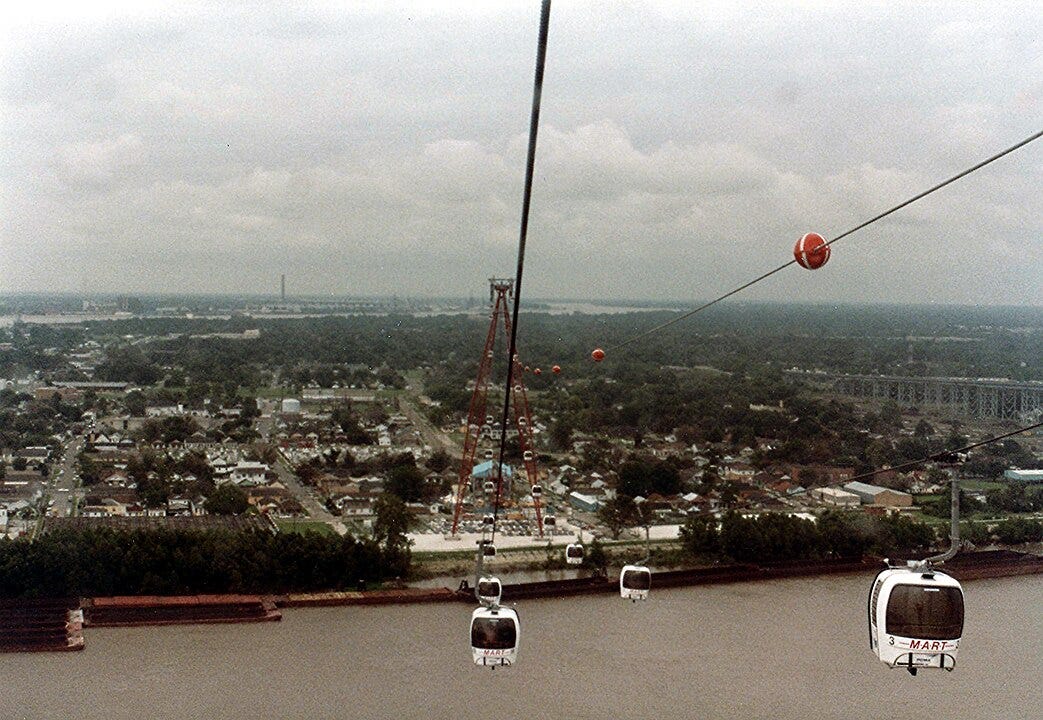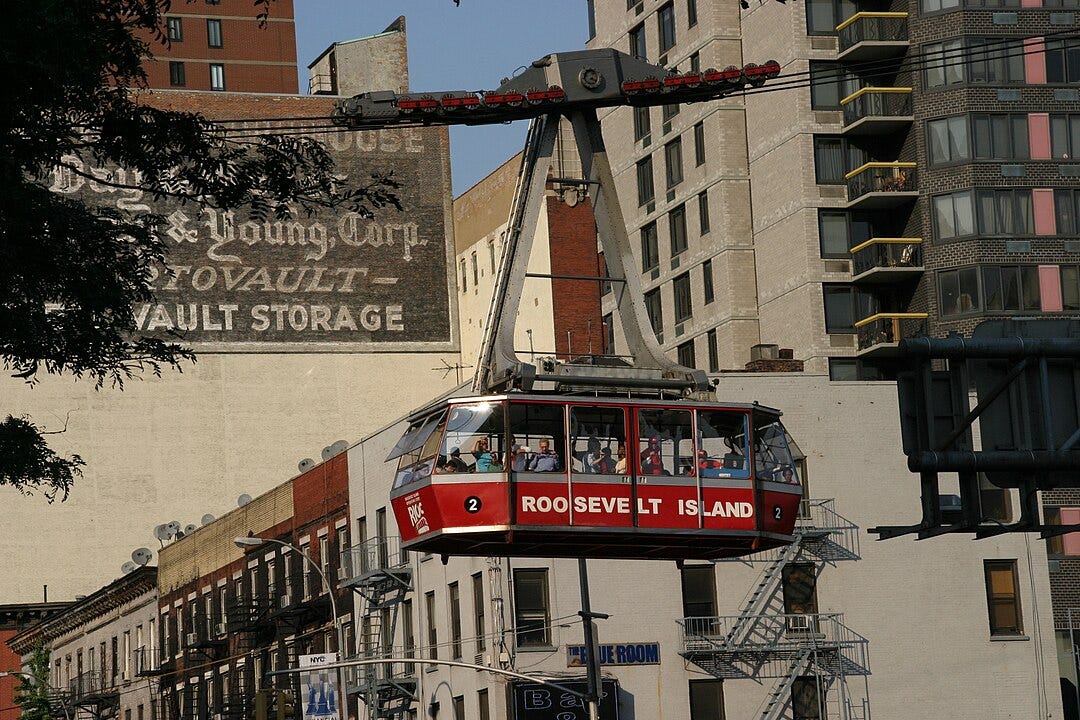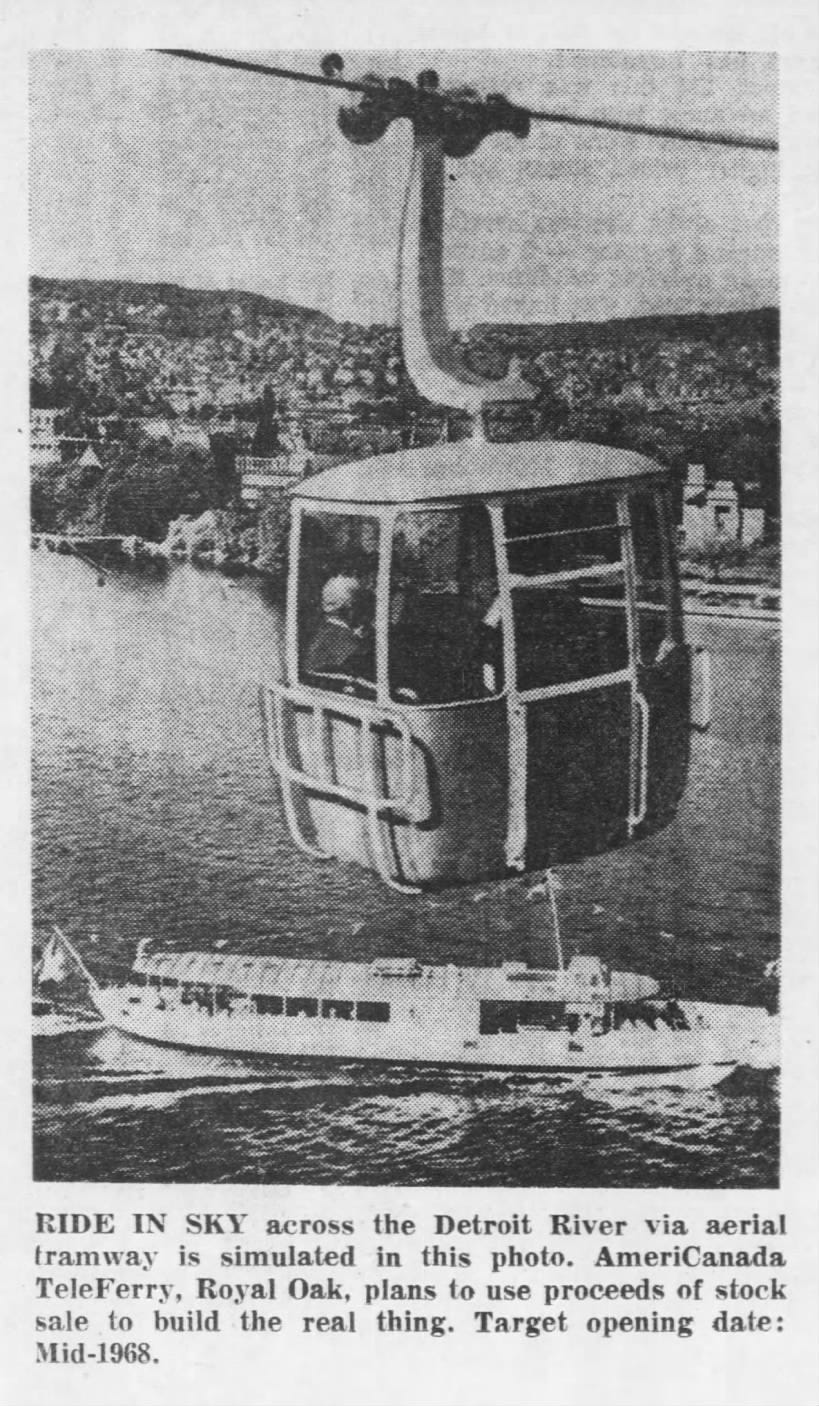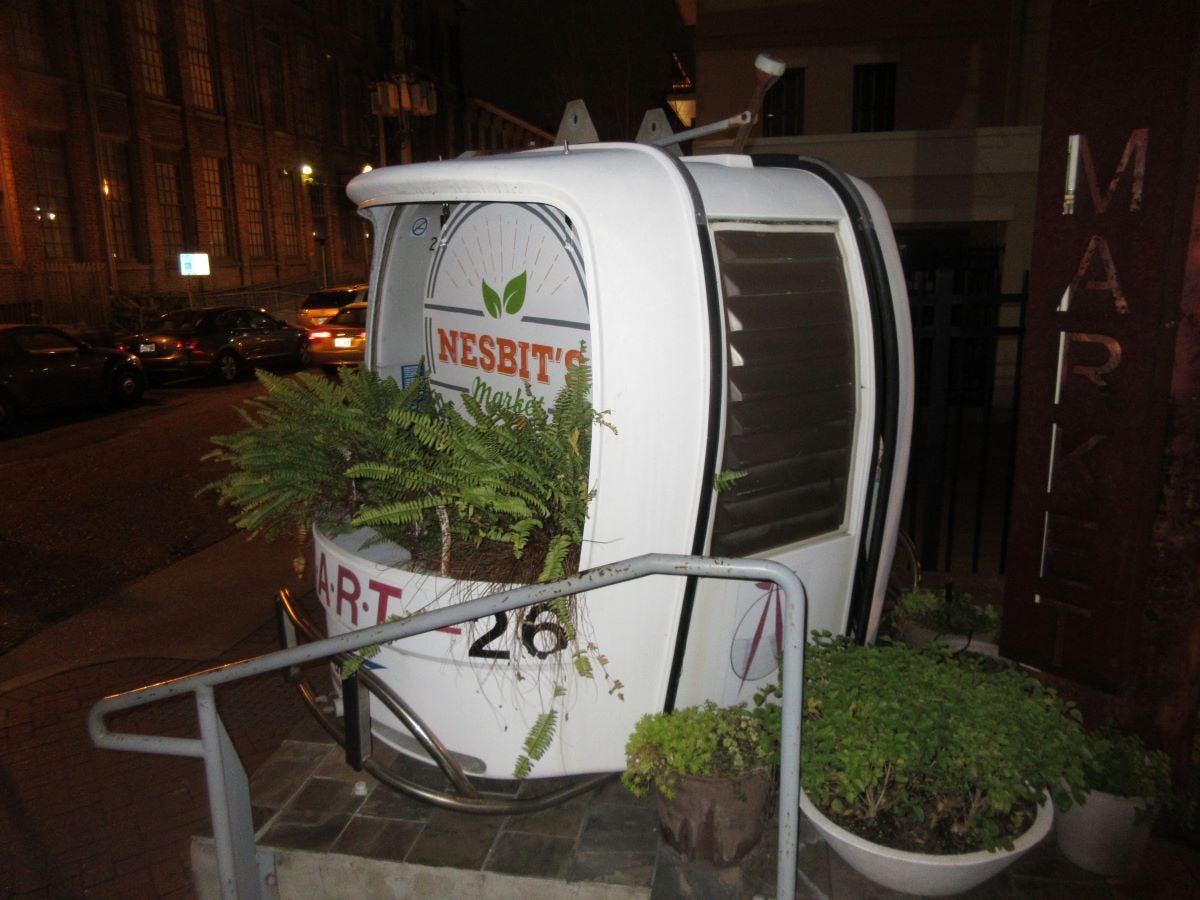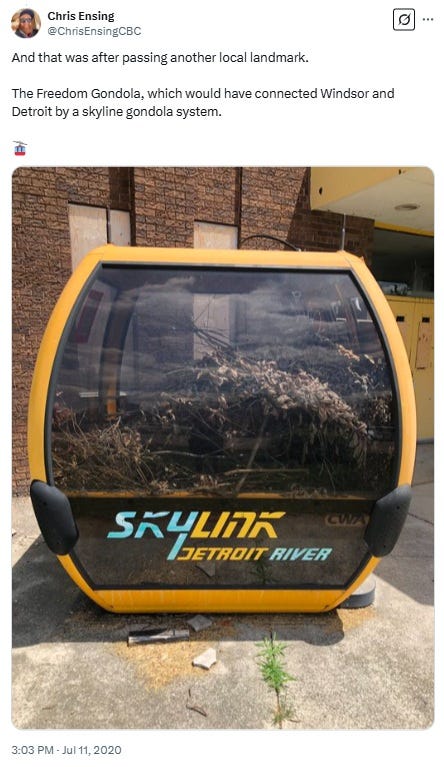The Mississippi Aerial River Transit at the 1984 Louisiana World’s Fair. Photo by Flickr photographer Carey Akin - Flickr photo, CC BY-SA 2.0.
In the mid-1980s, a transit system was proposed that would connect the U.S. and Canada in the friendliest way imaginable: a gondola lift, bobbing passengers over the river in round, cheerful cars. It would have been only the third urban aerial lift in the country, and the only one that crossed an international border, I’m pretty sure.
I wrote about the cable cars as part of a story about “the view from 1985” for the recent 40th anniversary issue of Crain’s Detroit Business. (Here is a gift link. HBD, CDB!) Poring over four big books of Crain’s papers published that year, I looked for reports about plans for the future of Detroit. I found stories about a network of skywalks connecting every building downtown, a robot that mixes your drinks at the bar, more RenCen-sized office towers on the riverfront, and something eventually happening at the Uniroyal site.
But the cable cars. I can’t stop thinking about the cable cars! A zany idea that might also be — a good idea? Maybe not? But it is a fun idea, and fun counts for something.
It is also a tenacious idea. In 1985, it was a revival of a revival of a plan that had been kicking around for at least 20 years. It would continue to kick around for the rest of the century. It is kicking around still!
At the time the Detroit-Windsor cable cars were proposed (1985 edition), there were only two other urban lift systems in the U.S. (as distinct from non-urban trams to mountaintops and ski resorts — there were, and are, plenty of those). One was the Roosevelt Island Tramway in New York City, which opened in 1976 as a temporary alternative to an under-construction subway line, and which proved popular enough to keep operating after the line was complete.
The Roosevelt Island Tramway, photographed in 2015. Photo by Andreas Geick, CC BY-SA 3.0.
The other was the Mississippi Aerial River Transit, aka the MART, a major attraction of the 1984 Louisiana World’s Fair. It was the MART that inspired Leon Atchison to revive (again) the Detroit-Windsor gondola concept. Atchison was then a civic affairs director for Michigan Consolidated Gas Co. and the former head of Mayor Coleman Young’s Parks and Recreation department; he had made a run at the gondola plan in that capacity in 1977. He told Crain’s in March of 1985 that two private groups were interested in financing the “estimated $9 million to $12 million project.”1 He also vowed that it would be better than the one in New Orleans.
“The one in New Orleans goes, literally, from no place to no place,” Atchison told Crain’s.2
Detroit and Windsor, though — now those are places. And the points of connection between them is one of the overarching subjects of this entire region’s history and identity, no?
The first pitch for the cable cars in 1965 really played this up. That pitch came from Royal Oak-based real estate developers and twin brothers George and Paul Amber, who were inspired by a “telepherique” they had seen on a Swiss lake. The Ambers envisioned the tramway as a kind of fairgrounds attraction; the tramway terminal would also feature a “stroll-in movie theatre,” “a zoo, a park, a lighted fountain,” and “annual swimming races across the river.” City Council approvals were underway by the spring of 1965, and the tram was expected to be operational in time for the 1967 International Freedom Festival.
But it would be a little more than just an amusement. Windsor, George Amber told the Free Press, was “last frontier ... the last undeveloped suburb close to downtown.” One day, he imagined, “there’ll be thousands of Americans commuting to work here from Windsor. And lots of ‘em will take the tramway.”
A rendering of the Amber brothers’ TeleFerry over the Detroit River, published in the Detroit Free Press, June 2, 1967.
By November, George Amber had incorporated the AmeriCanada TeleFerry Co. to operate the cable cars from Cobo Hall in Detroit to Cleary Auditorium in Windsor. The approximately 10-minute ride would cost 75 cents for a one-way fare. TeleFerry would pay the city $25,000 annually to lease the terminal space at Cobo and pay a graduated percentage of its revenue back to the city, maxing out at 50%.
But red tape and money-raising issues held up the groundbreaking. In 1967, TeleFerry tried to raise $2 million through a stock sale, but public response was “lukewarm.” The Ambers kept trying to raise the money privately; Paul Amber even went to Switzerland to try to persuade overseas investors to chip in. Ultimately, the city declined to renew TeleFerry’s lease3, and the project was declared dead in 1970.
I’m not totally sure how Atchison’s 1977/1985 idea(s) fell apart. But it was not auspicious that Atchison stopped talking publicly about his cable car plan, afraid of dooming it by association with the People Mover, a big debacle at the time. (More about that in the Crain’s story.)
Cable cars, forever on the horizon: There they are again in 1990, in the city’s 300-page 10-year master plan, with a parade of other unrealized visions: a downtown automotive museum, reviving Chaldean town, skywalks again! They’re back in the year 2000. This version, dubbed the Freedom Gondola, will cost $25 million to build4. The fare will be $3 for a 4.5-minute ride in the sky from Ford Auditorium (RIP) to Casino Windsor. The businessman behind this plan, Niels Jorgensen of Skylink International, says he will pay for it himself — no fundraising delays.
Jorgensen, the Detroit Free Press reported in 2001, was inspired by MART, too, but on the other side of the project — his company dismantled it in 1994. After the World’s Fair, the MART sat vacant for a decade before the U.S. Coast Guard finally ordered it to be torn down.
A repurposed MART cable car outside of a shop in New Orleans. Photo by Infrogmation of New Orleans - Own work, CC BY-SA 4.0.
Visionary Detroit city planner Alex Pollock5 also rode the MART in New Orleans. Unlike others who found the ride harrowing, Pollock thought it was “magnificent. At night, it was like flying over the city,” he told M.L. Elrick of the Detroit Free Press in 2001. Pollock had supported the Atchison plan (twice!) and thought Jorgensen might be the one to finally get it done.
But the mayoral election of 2001 changed the winds. Kwame Kilpatrick, apparently uninterested in the cable cars and with his own vision for the downtown riverfront, stopped taking Jorgensen’s calls. Jorgensen closed Skylink’s Detroit office in 2004.
This was the last time the Detroit-Windsor cable cars had a chance of becoming real, with an incorporated business, municipal buy-in on both sides of the border, a land acquisition strategy, and a plan to raise the money. But embers of the cable car plan still burn!
A protoype of a Skylink gondola car was still moldering outside of a defunct science center in Windsor as of 2020, according to this tweet from CBC journalist Chris Ensing.
In 2017, the idea was floated again as part of the Detroit-Windsor pitch for Amazon HQ26, which proposed a bi-national corporate headquarters with a campus on each side of the border. Windsor Mayor Drew Dilkins told The Windsor Star that his first email to Dan Gilbert included a pitch for the gondola to connect the sites. The final Detroit-Windsor HQ2 plan does not mention the gondola, though. Instead, it proposes water taxis — another eternally discussed international river transit idea that has not gone anywhere for decades and could use its own historical survey.
Will this idea ever end up on the table again? I’m not a transit nerd and I can’t tell you whether it might, or should. Someone maintains the website detroitwindsorgondola.com, which links to a concept study created by the consultancy SCJ Alliance in 2021. That’s interesting!
Of course, cable cars not likely to happen any time soon, given the recent harsh and unfair actions of the U.S. presidential administration toward our neighbors in Canada, and the justifiably unfriendly feelings in Canada toward the U.S. in response. (As much as I can’t stop thinking about the cable cars, I also can’t stop thinking about the tunnel bus.) Meanwhile we did build the DRIC, a humungous international infrastructure project that is maybe more monumental and inspiring than the cable car amuse-bouche would have been.
Still, as I was working on it, I found this story ringing a more poignant bell in my heart than is probably called for by a retro-futuristic stunt transit concept borne from a 1980s fairgrounds ride. I’m inspired by this idea persisting for like a half-century, its cables looping around and back and around again across time. It’s a deliriously optimistic idea, a children’s carnival dream. But it’s a dream of peace, and freedom, and flight, and birds-eye views, and I’m in love with it, I’ll just say it.7 I’m in love with what we come up with and the goofy-ass dreams we won’t let go.
the MART also cost $12 million to build, according to the New Orleans Historical Society, and charged $3.50 for a round-trip ride.
My husband knew about the MART from this 2003 documentary about the 1984 Louisiana World’s Fair that he caught on PBS on some trip to New Orleans. The whole doc is suuuuper soothing and enjoyable and I heartily recommend it, but at least watch the segment about the gondola, described by people who rode it as “terrifying” and “incredibly scary.”
the property they were leasing would eventually become the site of Joe Louis Arena, the development of which may have had something to do with the Ambers losing their lease.
this cost estimate later increased to $75 million.
his resume includes the Washington Blvd. trolleys, the 1970s-era Eastern Market murals, and saving the old Central Market building that was repurposed on Belle Isle before moving to Greenfield Village a few years ago.
remember that pre-pandemic fever dream??? look forward to writing that historical sidenote one day!
personally I would also be terrified to ride it!



